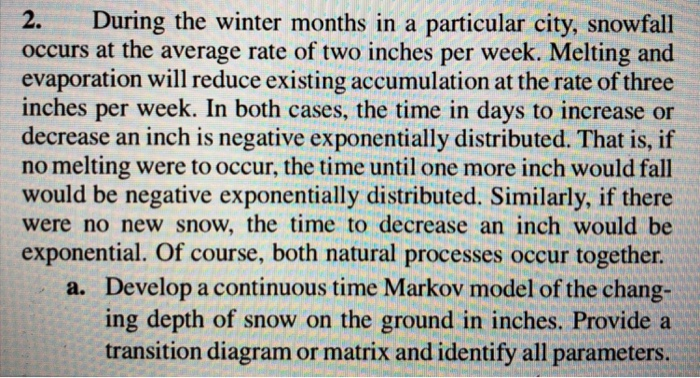2. During the winter months in a particular city, snowfall occurs at the average rate of two inches per week. Melting and evaporation will reduce existing accumulation at the rate of three inches per week. In both cases, the time in days to increase or decrease an inch is negative exponentially distributed. That is, if no melting were to occur, the time until one more inch would fall would be negative exponentially distributed. Similarly, if there were no new snow, the time to decrease an inch would be exponential. Of course, both natural processes occur together. a. Develop a continuous time Markov model of the chang- ing depth of snow on the ground in inches. Provide a transition diagram or matrix and identify all parameters.
2. During the winter months in a particular city, snowfall occurs at the average rate of two inches per week. Melting and evaporation will reduce existing accumulation at the rate of three inches per week. In both cases, the time in days to increase or decrease an inch is negative exponentially distributed. That is, if no melting were to occur, the time until one more inch would fall would be negative exponentially distributed. Similarly, if there were no new snow, the time to decrease an inch would be exponential. Of course, both natural processes occur together. a. Develop a continuous time Markov model of the chang- ing depth of snow on the ground in inches. Provide a transition diagram or matrix and identify all parameters.
College Algebra (MindTap Course List)
12th Edition
ISBN:9781305652231
Author:R. David Gustafson, Jeff Hughes
Publisher:R. David Gustafson, Jeff Hughes
Chapter5: Exponential And Logarithmic Functions
Section5.2: Applications Of Exponential Functions
Problem 44E: Use a graphing calculator to solve each problem. In Example 4, suppose that a birth control program...
Related questions
Question

Transcribed Image Text:b. Is the Markov assumption reasonable? Discuss factors
that would tend to affirm or refute the assumption.
(Don't worry about stationarity.)
c. Show how to compute the fraction of time there is more
than three inches of snow on the ground.

Transcribed Image Text:2. During the winter months in a particular city, snowfall
occurs at the average rate of two inches per week. Melting and
evaporation will reduce existing accumulation at the rate of three
inches per week. In both cases, the time in days to increase or
decrease an inch is negative exponentially distributed. That is, if
no melting were to occur, the time until one more inch would fall
would be negative exponentially distributed. Similarly, if there
were no new snow, the time to decrease an inch would be
exponential. Of course, both natural processes occur together.
a. Develop a continuous time Markov model of the chang-
ing depth of snow on the ground in inches. Provide a
transition diagram or matrix and identify all parameters.
Expert Solution
This question has been solved!
Explore an expertly crafted, step-by-step solution for a thorough understanding of key concepts.
This is a popular solution!
Trending now
This is a popular solution!
Step by step
Solved in 3 steps

Recommended textbooks for you

College Algebra (MindTap Course List)
Algebra
ISBN:
9781305652231
Author:
R. David Gustafson, Jeff Hughes
Publisher:
Cengage Learning

Algebra and Trigonometry (MindTap Course List)
Algebra
ISBN:
9781305071742
Author:
James Stewart, Lothar Redlin, Saleem Watson
Publisher:
Cengage Learning

College Algebra
Algebra
ISBN:
9781305115545
Author:
James Stewart, Lothar Redlin, Saleem Watson
Publisher:
Cengage Learning

College Algebra (MindTap Course List)
Algebra
ISBN:
9781305652231
Author:
R. David Gustafson, Jeff Hughes
Publisher:
Cengage Learning

Algebra and Trigonometry (MindTap Course List)
Algebra
ISBN:
9781305071742
Author:
James Stewart, Lothar Redlin, Saleem Watson
Publisher:
Cengage Learning

College Algebra
Algebra
ISBN:
9781305115545
Author:
James Stewart, Lothar Redlin, Saleem Watson
Publisher:
Cengage Learning


Algebra & Trigonometry with Analytic Geometry
Algebra
ISBN:
9781133382119
Author:
Swokowski
Publisher:
Cengage

Trigonometry (MindTap Course List)
Trigonometry
ISBN:
9781337278461
Author:
Ron Larson
Publisher:
Cengage Learning